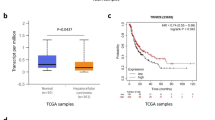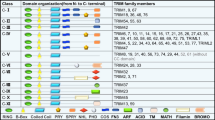Abstract
Tripartite motif-containing 29 (TRIM29), also known as ataxia-telangiectasia group D, is structurally a member of the tripartite motif family of proteins, which characterized by the conserved RING finger, B-box, and coiled-coil domains. TRIM29 functions as an oncogene or a tumor suppressor depending on the tumor types. In this study, we aim to evaluate whether TRIM29 affects the tumorigenesis and progression of colorectal cancer. The expression of TRIM29 was investigated using real-time PCR in 40 pairs of colorectal cancer tissues and immunohistochemistry on a tissue microarray containing 203 cases of primary colorectal cancer paired with non-cancerous tissues. Down-regulation of TRIM29 was achieved by transient transfection in RKO cell lines, and the effects of TRIM29 on tumor proliferation were evaluated by MTT and plate colony formation assays. Results indicated that TRIM29 expression was much higher in colorectal cancer tissues and significantly associated with the depth of tumor invasion, lymph node metastasis, distant metastasis, histological differentiation, vascular invasion, ki-67 index, and advanced tumor stage. Patients with TRIM29-positive tumors had a higher recurrence rate and poorer survival than patients with TRIM29-negative tumors. In multivariate analyses, the TRIM29 expression was an independent factor for determining colorectal cancer prognosis after surgery. Moreover, down-regulation of TRIM29 inhibited tumor cell proliferation in vitro. In conclusion, TRIM29 plays an important role in promoting colorectal cancer progression. Our findings suggest that TRIM29 may serve as a novel biomarker for tumor recurrence and survival for colorectal cancer patients.





Similar content being viewed by others
References
Jemal A, et al. Cancer statistics, 2010. CA Cancer J Clin. 2010;60(5):277–300.
Gaedcke J, et al. The rectal cancer microRNAome–microRNA expression in rectal cancer and matched normal mucosa. Clin Cancer Res. 2012;18(18):4919–30.
Siegel R, et al. Cancer statistics, 2011: the impact of eliminating socioeconomic and racial disparities on premature cancer deaths. CA Cancer J Clin. 2011;61(4):212–36.
Zhang S, et al. Changes on the disease pattern of primary colorectal cancers in Southern China: a retrospective study of 20 years. Int J Colorectal Dis. 2009;24(8):943–9.
Schepeler T, et al. Diagnostic and prognostic microRNAs in stage II colon cancer. Cancer Res. 2008;68(15):6416–24.
Compton CC, et al. Prognostic factors in colorectal cancer. College of American Pathologists Consensus Statement 1999. Arch Pathol Lab Med. 2000;124(7):979–94.
Nakamura Y, et al. Case of the multiple liver metastases from colon cancer obtained long-term disease-free survival with multimodality therapy. Gan To Kagaku Ryoho. 2012;39(12):2228–30.
Fearon ER. Molecular genetics of colorectal cancer. Annu Rev Pathol. 2011;6:479–507.
Yamaguchi H, Hsu JL, Hung MC. Regulation of ubiquitination-mediated protein degradation by survival kinases in cancer. Front Oncol. 2012;2:15.
Reymond A, et al. The tripartite motif family identifies cell compartments. EMBO J. 2001;20(9):2140–51.
Quaderi NA, et al. Opitz G/BBB syndrome, a defect of midline development, is due to mutations in a new RING finger gene on Xp22. Nat Genet. 1997;17(3):285–91.
Wang L, et al. Oncogenic function of ATDC in pancreatic cancer through Wnt pathway activation and beta-catenin stabilization. Cancer Cell. 2009;15(3):207–19.
Kosaka Y, et al. Tripartite motif-containing 29 (TRIM29) is a novel marker for lymph node metastasis in gastric cancer. Ann Surg Oncol. 2007;14(9):2543–9.
Mutter GL, et al. Global expression changes of constitutive and hormonally regulated genes during endometrial neoplastic transformation. Gynecol Oncol. 2001;83(2):177–85.
Santin AD, et al. Gene expression profiles in primary ovarian serous papillary tumors and normal ovarian epithelium: identification of candidate molecular markers for ovarian cancer diagnosis and therapy. Int J Cancer. 2004;112(1):14–25.
Dyrskjot L, et al. Gene expression in the urinary bladder: a common carcinoma in situ gene expression signature exists disregarding histopathological classification. Cancer Res. 2004;64(11):4040–8.
Hawthorn L, et al. Characterization of cell-type specific profiles in tissues and isolated cells from squamous cell carcinomas of the lung. Lung Cancer. 2006;53(2):129–42.
Li D, et al. IMP3 is a novel prognostic marker that correlates with colon cancer progression and pathogenesis. Ann Surg Oncol. 2009;16(12):3499–506.
Wang X, et al. Reduced expression of PER3 is associated with incidence and development of colon cancer. Ann Surg Oncol. 2012;19(9):3081–8.
Yan DW, et al. Ubiquitin D is correlated with colon cancer progression and predicts recurrence for stage II-III disease after curative surgery. Br J Cancer. 2010;103(7):961–9.
Reddy BA, Etkin LD, Freemont PS. A novel zinc finger coiled-coil domain in a family of nuclear proteins. Trends Biochem Sci. 1992;17(9):344–5.
Borden KL. RING fingers and B-boxes: zinc-binding protein–protein interaction domains. Biochem Cell Biol. 1998;76(2–3):351–8.
Leonhardt EA, et al. Nucleotide sequence analysis of a candidate gene for ataxia-telangiectasia group D (ATDC). Genomics. 1994;19(1):130–6.
Sardiello M, et al. Genomic analysis of the TRIM family reveals two groups of genes with distinct evolutionary properties. BMC Evol Biol. 2008;8:225.
Brzoska PM, et al. The product of the ataxia-telangiectasia group D complementing gene, ATDC, interacts with a protein kinase C substrate and inhibitor. Proc Natl Acad Sci U S A. 1995;92(17):7824–8.
Lawson JC, Blatch GL, Edkins AL. Cancer stem cells in breast cancer and metastasis. Breast Cancer Res Treat. 2009;118(2):241–54.
Yuan Z, et al. The ATDC (TRIM29) protein binds p53 and antagonizes p53-mediated functions. Mol Cell Biol. 2010;30(12):3004–15.
Sho T, et al. TRIM29 negatively regulates p53 via inhibition of Tip60. Biochim Biophys Acta. 2011;1813(6):1245–53.
Shibata MA, et al. Suppression of mammary carcinoma growth in vitro and in vivo by inducible expression of the Cdk inhibitor p21. Cancer Gene Ther. 2001;8(1):23–35.
Acknowledgments
The project was supported by the grants from National Natural Science Foundation of China (81072008, 81172328) and Medical engineering crossing project grant funded by Shanghai Jiaotong University (YG2011MS59).
Conflicts of interest
None.
Author information
Authors and Affiliations
Corresponding authors
Additional information
Tao Jiang and Huamei Tang have contributed equally to this work.
Rights and permissions
About this article
Cite this article
Jiang, T., Tang, Hm., Lu, S. et al. Up-regulation of tripartite motif-containing 29 promotes cancer cell proliferation and predicts poor survival in colorectal cancer. Med Oncol 30, 715 (2013). https://doi.org/10.1007/s12032-013-0715-4
Received:
Accepted:
Published:
DOI: https://doi.org/10.1007/s12032-013-0715-4




